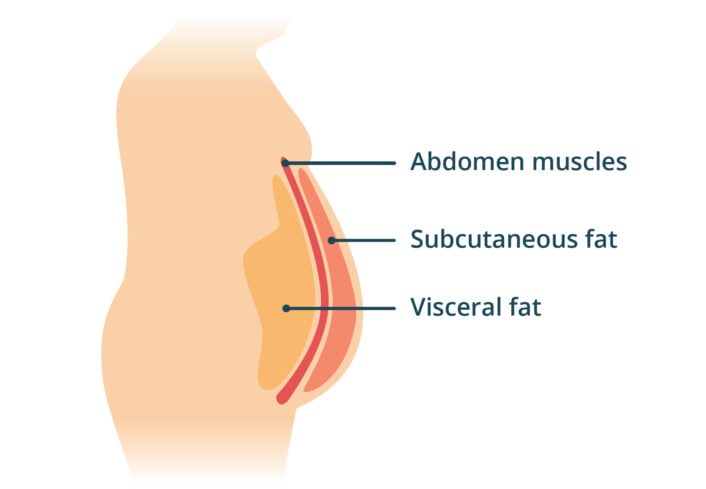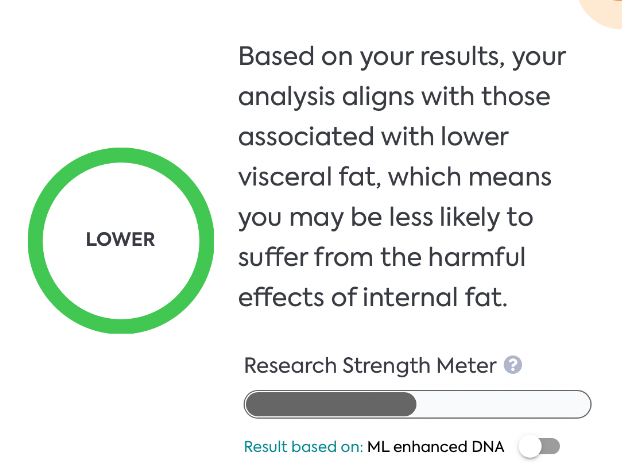

Visceral fat serves several vital functions, including cushioning and protecting organs, storing energy, and releasing hormones to regulate metabolism. However, excessive accumulation of visceral fat can lead to health problems.
Excessive visceral body fat is associated with various health risks and can harm overall health. Unlike subcutaneous fat, which primarily affects appearance, visceral fat is metabolically active and secrete hormones and inflammatory substances that can disrupt normal bodily functions.
High levels of visceral fat are associated with an increased risk of several health conditions, including type 2 diabetes, cardiovascular disease, insulin resistance, hypertension, and certain cancers. Additionally, visceral fat is closely associated with metabolic syndrome, a cluster of conditions that increase the risk of heart disease, stroke, and diabetes.
Given its proximity to vital organs, visceral fat can significantly impact health more than subcutaneous fat. Therefore, reducing visceral fat is crucial for lowering the risk of obesity-related diseases and improving overall health.
Early studies on visceral body fat have highlighted its genetic origins. A 1997 paper examining the genetic susceptibility to visceral fat observed that genetic influences contribute to variations in body fat distribution. Additionally, genetic susceptibility may impact the relationship between visceral fat accumulation and metabolic alterations, with specific gene polymorphisms altering the association between visceral obesity and plasma lipoprotein-lipid levels. The findings underscore genetic factors’ significant influence on visceral adipose tissue accumulation and its association with metabolic alterations.
The CRYBG1 gene, or “Cryptochrome Binding Globulin 1,” encodes a protein in circadian rhythm regulation and lipid metabolism. Recent research has suggested a potential association between variations in the CRYBG1 gene and visceral body fat accumulation. Studies have indicated that specific genetic variants of CRYBG1 may be associated with increased visceral adipose tissue (VAT) deposition, particularly in individuals with obesity or metabolic disorders.
According to a 2019 GWAS, the major allele of SNP rs803522 has a potential to increase visceral fat accumulation, consistent across both adolescents and adults.
However, the exact mechanism by which CRYBG1 influences visceral fat accumulation is still under investigation. Further research is needed to fully elucidate the role of CRYBG1 in adipose tissue biology and its implications for metabolic health.
Interestingly, the SNP rs803522 is near yet another gene, ATG5, a gene crucial for modulating adipocyte size and macrophage polarization. ATG5 plays a vital role in autophagy, a cellular process responsible for maintaining energy balance and homeostasis by degrading damaged organelles and mobilizing intracellular nutrients, including lipids.
Studies in mice have shown that overexpression of mouse Atg5 gene reduces body fat accumulation and prolongs lifespan. Deletion of Atg5 in adipocytes increases adiposity by altering lipid storage and burning capacities. Similar effects were observed with the deletion of Atg7, a molecular partner of ATG5. In humans, ATG5 expression is higher in obese individuals compared to lean ones and changes in response to caloric restriction or bariatric surgery.
Reducing visceral body fat involves adopting a comprehensive approach that includes dietary changes, regular physical activity, and lifestyle modifications:
The body doesn’t selectively burn visceral fat as a primary fuel source. When you engage in activities that require energy, such as exercise, the body draws upon stored fat reserves for fuel. However, the specific fat stores mobilized for energy depend on various factors, including genetics, hormone levels, and overall metabolic health.
During periods of energy expenditure, the body typically mobilizes fat stores from multiple locations, including subcutaneous and visceral fat stores, to meet energy demands. While visceral fat can contribute to overall fat loss, the body doesn’t prioritize burning visceral fat over other fat stores.
Therefore, reducing visceral fat requires a comprehensive approach focusing on overall fat loss through diet, exercise, and lifestyle modifications rather than relying on targeted fat-burning strategies.
We cannot directly measure visceral body fat through traditional methods like body mass index (BMI) or skinfold calipers.
However, several indirect methods can estimate visceral fat levels:
While these methods can estimate visceral fat levels, it’s essential to interpret results with other health indicators and consult a healthcare professional for personalized recommendations.
Understanding your unique genetic makeup can be a game-changer in fitness and personal health. By delving into the details of your DNA, you can gain valuable insights into various aspects of your physical wellness and exercise preferences. We can leverage it to tailor a fitness regimen that aligns with your body’s intrinsic characteristics.

The LifeDNA Fitness report has nearly 30 traits, including Visceral Fat susceptibility. Get your report here.
*Understanding your genetics can offer valuable insights into your well-being, but it is not deterministic. Your traits can be influenced by the complex interplay involving nature, lifestyle, family history, and others.
Our reports have not been evaluated by the Food and Drug Administration. The contents on our website and our reports are for informational purposes only, and are not intended to diagnose any medical condition, replace the advice of a healthcare professional, or provide any medical advice, diagnosis, or treatment. Consult with a healthcare professional before making any major lifestyle changes or if you have any other concerns about your results. The testimonials featured may have used more than one LifeDNA or LifeDNA vendors’ product or reports.


